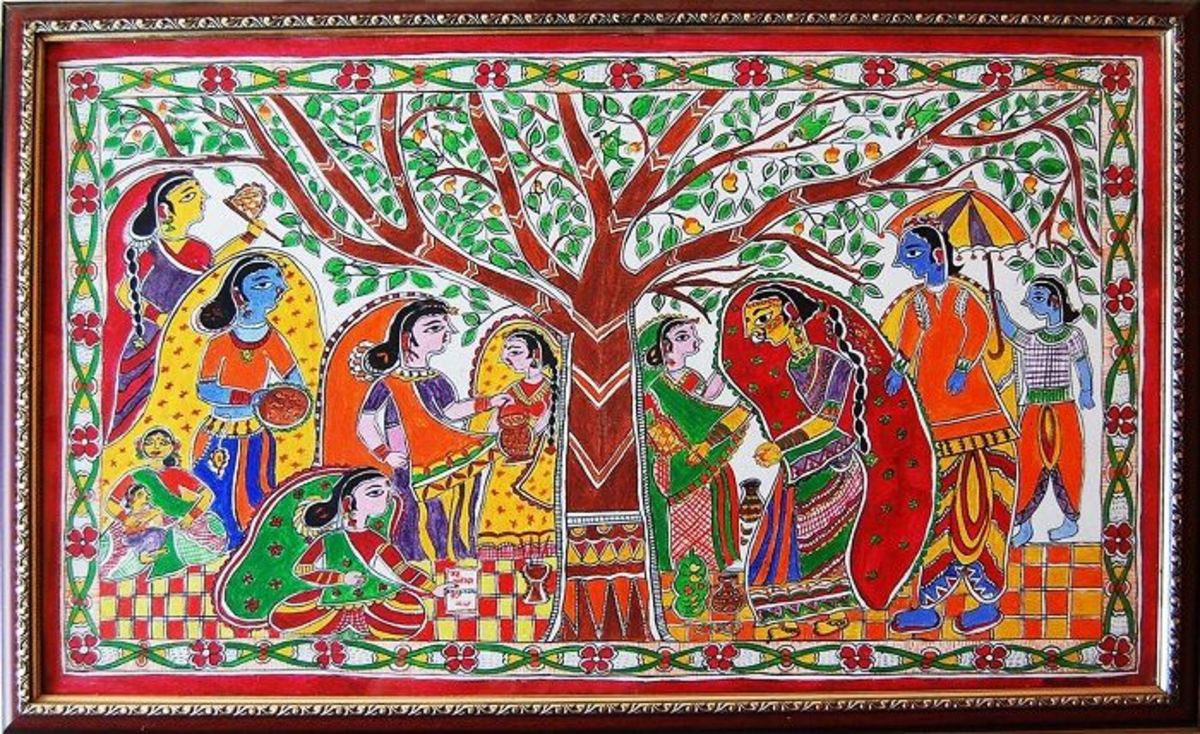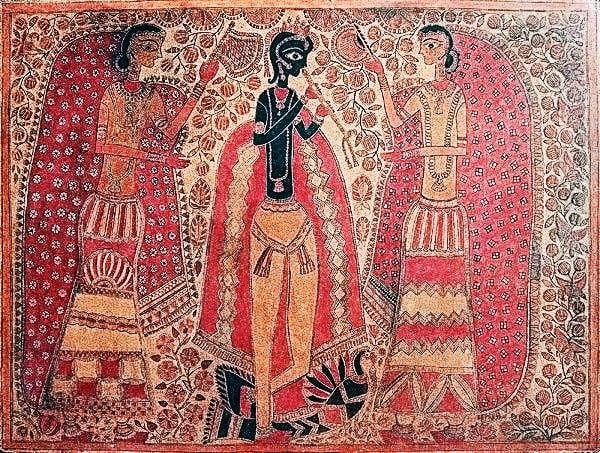Owing to its rich heritage, India has been referred to as the “Sone ki Chidiya”, i.e. the Golden Sparrow in the past. The earliest forms of Indian Art originated back in around 3500 BC and the history of these forms have been massively influenced by the cultural as well as religious aspects. The diverse culture of the country has its impactful imprint on the aesthetic masterpieces, be it paintings, sculptures, writings or musical works. Having been gloriously blessed with a picturesque landscape and a glorious history, India is renowned as a scintillating combination of spiritual as well as modern! Through this blog, we will take you on a fun-filled ride into the history of Indian art, delving deeper into its milestones as well as a detailed overview of varied styles and forms.
Also Read: Fine Arts Courses
This Blog Includes:
Brief History of Indian Art
The origins of Indian Art find their way back in the roots of civilization. It was when the Indus Valley Civilization reached its peak that most Indian art forms are believed to be originated. To help you understand the history of Indian Art through different periods, we have curated a comprehensive table listing down the varied forms found during these times.

| Period | Indian Art Forms |
| Indian Art from Ancient Times | Bhimbetka Prehistoric Art Indus Valley Art (2nd Century B.C.) |
| Early Indian Art | Buddhist Art from Gandhara and Kushan School (1st Century A.D.) Caves of Ajanta and Ellora (5th Century A.D.) Chalukyan Art of Badami(6th Century A.D.) |
| Medieval | Chola Art of Deccan (10-13th Centuries A.D.) Hoysala Art of Belur and Halebid (12th Century A.D.) Temples of Khajuraho(10th Century A.D.) Konark & Kalinga Art(13th Century A.D.) |
| 15th-19th Century Art | Moghul Miniatures Indo-Saracenic Architecture (Taj Mahal) Dakhani Miniatures(17-19th Century) Mysore and Tanjore Schools of Art |
| Contemporary and Modern Indian Art | Raja Ravi Varma Paintings Textbook Illustrations Modern Buildings (Lotus Temple) |
Ancient Period
Archaeologists have found evidence of prehistoric rock art in India, an early art form consisting of carvings or drawings on cave rocks. The oldest examples are the Bhimbetka petroglyphs found in central India and believed to be at least 290,000 years old. Rock art continued to be created as cave paintings, representing animals and humans. The oldest examples of these paintings date from about 7000 BCE.

Indus Valley Art
From the 2nd Century B.C., the Indus Valley Civilisation flourished in the northwest area of the country, which is Pakistan to the present date. The evolution towards a sophisticated and civilised culture happened in the Harappan period. Roughly dating somewhere from 3200-1200, the history of Indian Art during the Indus Valley civilisation is observed to be influenced by the advancements that happened in Science and Culture. The artistic expression of this period can be traced back to Rock paintings and Temple Arts. The people of the Indus valley civilization produced the earliest known Indian art sculptures, from between 2500 and 1800 BCE. They were small terracotta and bronze figures depicting animals and humans, like cows, monkeys, and dancing positions.

Buddhism and Hinduism Influenced Art
Buddhism originated in India at some point in the 6th century BCE. Religious artists made sculpture pieces, including stone and bronze. They also produced magnificent examples of Indian cave art, with entire temples being carved in stone and decorated with Greek-influenced columns and sculptures. By the 5th century CE, the sculpture was a common practice among Indian Buddhists and Hindus. Hinduism continued to be the focus of art creation for centuries, sculptures of Shiva and other deities, and huge stone temples like the Kandariya Mahadeva Temple, built in the 11th century in northern India.

Islamic Influence
In the 12th century, there was a gradual Muslim conquest in India with the establishment of various Islamic States during that time. Islam gradually gained importance in India and under the Mughal Empire, established in the 16th century. The beautiful influence of Islamic culture came with the invasion of Mughals and other Islamic rulers. With Mughals rule during the 16th century- mid 19th century, changed the entire complexion of the country leaving a lasting impression on India’s Culture, Clothing and especially in Indian Art and Paintings. Their influence can be traced to the architecture and monuments built by them during that time like the Taj Mahal.

Colonial Era
A defining moment in the History of Indian Art, which came during the western influence on the country’s heritage, was with the arrival of Vasco da Gama at the end of the 15th century, who established a direct link with India for trade. Slowly and gradually during the 17th century, France, Netherlands and Denmark and England began facilitating trade with India. With the fall of Maratha rule in the 18th century, European countries started entering India from its different regions. The British power expanded with the defeat of Tipu Sultan and by the mid-19th century, the country find itself covered under the British Empire’s governance. The western and European influence on India during that time is something that can be experienced in Indian’s culture and art even today. This resulted in local artistic traditions merging with foreign influences. A romanticized Indian style developed, which exaggerated traditional ornaments to please the European buyers.

The Independence Era
India became independent on 15th August 1947, after decades of British rule. With raging world wars, invasion, oppression, struggle, independence and evolution of culture, the country went through a long period of struggle and these aspects have impacted the history of Indian art and culture to a very great extent.
Also Read: Career in Painting
History of Indian Art: Styles
Traditional Indian Art consists of religious characters (Gods and Idols) in Hinduism, Islam, and Buddhism which have been a common theme throughout centuries. Sculptures and cave paintings found in ancient times mainly featured human, mythological, elaborated ornaments and animals forms. In the medieval period, Islam as well as the Indian art didn’t relinquish figural representations. Each style of art is unique in its own way and greatly admirable. Traditionally, these art styles existed only in wall paintings or murals. But today, they are also found in canvas, paper, cloth, etc. Here is a list of different Indian art styles, some still in practice and others not.
Madhubani Painting
This art is also known as Mithila art, and it originated in the kingdom of Janak in Nepal and in present-day Bihar. This art form was not known to the rest of the world until the 1930s when it was discovered after an earthquake. Mostly practised by women, these paintings or wall murals depict gods, fauna and flora. Characterised by geometric patterns, this art form is greatly admired for its evocative portrayal of traditions and cultures.

Warli Painting
This form of art dates back to 2500 BCE, and it was practised by the Warli tribes belonging to Thane and Nasik in Maharashtra. These paintings mostly illustrate the nature and social rituals of the tribe. It portrays daily activities like farming, praying, dancing, hunting, etc. Geometrical patterns in white against a yellow or red background are some of the main themes. Warli paintings were usually made by married women to celebrate a wedding, and they were also used to decorate huts of the Warli tribes.

Miniature Painting
The miniature paintings illustrate a combination of Indian, Islamic and Persian art styles. This art form dates back to the 16th century, and the themes are usually centred on battles, court scenes, portraits, wildlife, receptions, hunting scenes, legendary stories etc. Natural stone colours are used in a paper-based “wasli” for the creation of these paintings. The miniature paintings have developed into several distinct schools of miniature like Mughal, Rajasthan, Deccan, Kangra, Malwa, Pahadi, etc.

Kalamkari
Having a strong connection to Persian motifs, this art has been in practice for more than 3000 years. Kalamkari derives its name from kalam or pen, and it means ‘drawings with a pen’. This organic art of hand and block printing has survived generations in Andhra Pradesh. Kalamkari art involves earthy colours like green, rust, indigo, mustard and black. Today this art is used in ethnic clothing and depicts anything from fauna and flora to epics such as Mahabharata or Ramayana.

Tanjore Painting
First painted in the 16th century under the Chola regime, this painting originated in the Thanjavur district in Tamil Nadu. It is known for its magnificent embellishments, vibrant colours and rich surfaces. The themes are mainly centred on the Hindu gods and goddesses. These paintings are made on wooden planks, and the main subjects are always painted in the centre. The styles of this painting are similar to that of the Deccani and Maratha art, as well as to the European styles.

History of Indian Art: Forms
Architecture
During the latter phase of the medieval period of the history of Indian Art, architecture was mostly focused on religious monuments and buildings. Arguably the two greatest creations of Architecture from the Indian subcontinent are Kandariya Mahadeva Hindu Temple at Khajuraho which was built in the 11th century and the Taj Mahal at Agra constructed in the 17th century.

Schools of Paintings
Due to the diversity in the geography, climate, demographics and local cultural traditions, there is a varied range of styles of paintings in the country. Indian art has taken shape along the regional lines and due to artistic influence felt in regional borders. Paintings and art forms in India is a complex patchwork of different styles and approaches to both figure drawings and paintings. Some of the well-known paintings in the history of Indian Art are:

- Madhubani Paintings
- Rajput Paintings
- Miniature Paintings
- Mysore Paintings
- Bengal Paintings
Those curious about delving deeper into the history of Indian Art, there is a plethora of courses on offer in this vast domain of study. Check out our exclusive blogs on the different degree programs in Arts and History that you can choose from:
- Bachelor of Fine Arts
- Master of Fine Arts
- MA History
- BA History
History of Indian Art PDF
Hence, we hope that this blog has helped you understand the history of Indian Art, its origins and various forms and styles. If you are interested in exploring the arena of History but don’t know which program to opt for, then sign up for a 30-minute free career counselling session with our Leverage Edu experts and we’ll guide you in finding a suitable course and university that fits your interests and preferences and equips you with the required knowledge and exposure to discover this field.
-
It is nice to go through our origin of art and it’s forms.thank u so much for this valuable info sir.
-
Hi, Karthik!
Thank you for your valuable feedback.
Keep yourself updated with our upcoming content.
Here we are referring you some related articles to read: History of English Literature
History Of Indian Civil Services
Notes on the History of Medieval India
-
-
Thnk you for the best information
-
Thank you for your feedback. Read more such blogs on- https://leverageedu.com/blog.
-

 One app for all your study abroad needs
One app for all your study abroad needs





















 45,000+ students realised their study abroad dream with us. Take the first step today.
45,000+ students realised their study abroad dream with us. Take the first step today.


5 comments
It is nice to go through our origin of art and it’s forms.thank u so much for this valuable info sir.
Hi, Karthik!
Thank you for your valuable feedback.
Keep yourself updated with our upcoming content.
Here we are referring you some related articles to read: History of English Literature
History Of Indian Civil Services
Notes on the History of Medieval India
Thnk you for the best information
Thank you for your feedback. Read more such blogs on- https://leverageedu.com/blog.
The information is given on the site about history of Indian’s Fine art, is good to know in brief, thank you for providing.